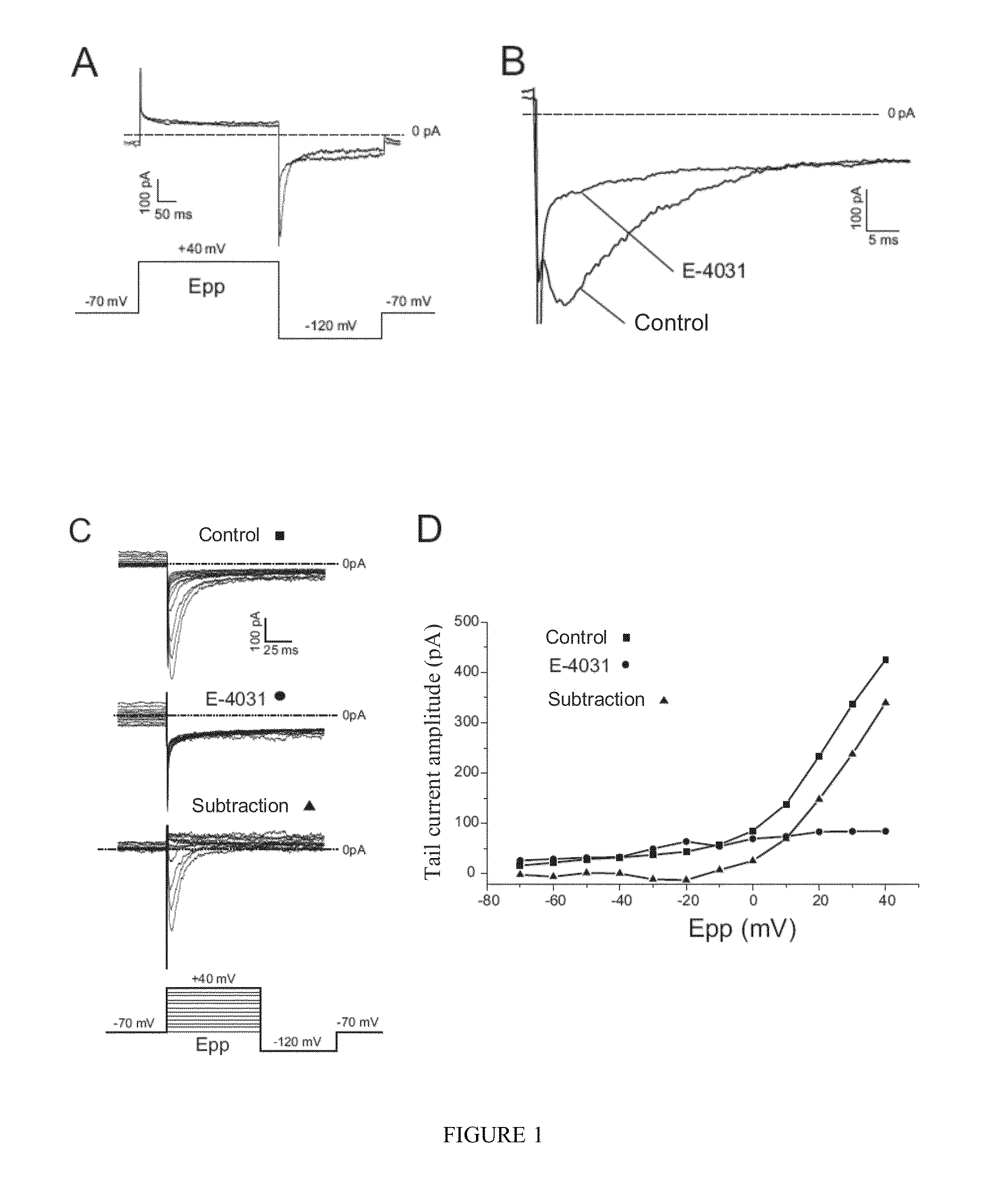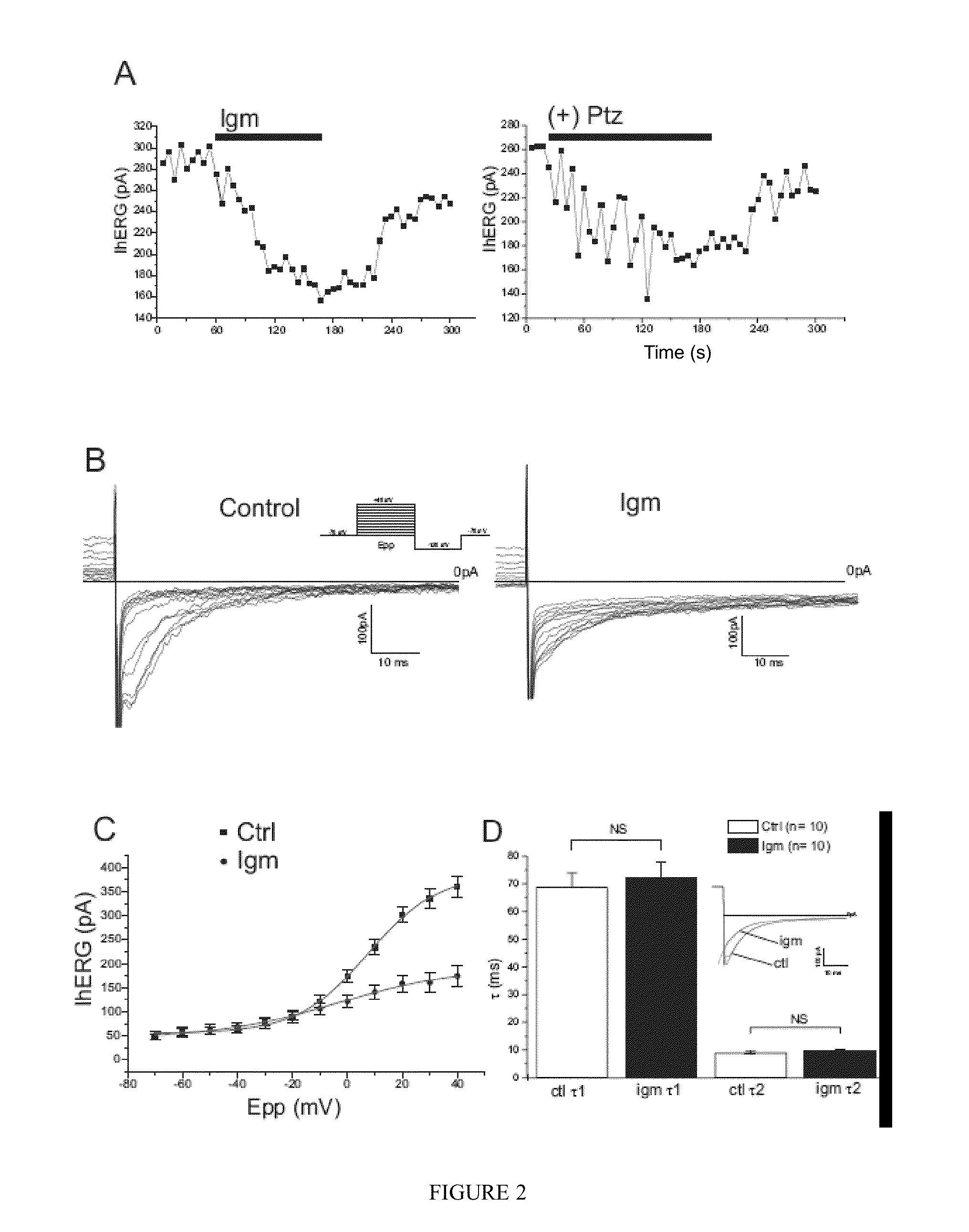INHIBITORS OF THE INTERACTION OF THE SIGMA-1 RECEPTOR WITH hERG FOR USE IN THE TREATMENT OF CANCER
a technology of sigma-1 receptor and inhibitor, which is applied in the field of sigma1 receptor, can solve the problems of side effects and dangerous use of these molecules in patients
- Summary
- Abstract
- Description
- Claims
- Application Information
AI Technical Summary
Benefits of technology
Problems solved by technology
Method used
Image
Examples
example 1
The Sigma Ligands Inhibit the hERG Current in K562 Cells
[0033]“Patch-clamp” electrophysiology experiments were carried out in the whole cell configuration. The extracellular saline solution bathing the cells contains a high potassium concentration in order to improve the amplitude of the inward potassium current at −120 mV. The hERG currents were analyzed as abovementioned tail currents at −120 mV following prepulses of −70 to 40 mV. This protocol makes it possible to record transient inward currents, the amplitude of which correlates with the depolarization involved during the prepulses. These currents were completely eliminated by the perfusion of the hERG-specific inhibitor E-4031 (1 μM) [11] (FIG. 1 A,B). In addition, the graphic subtraction revealed that E-4031 inhibits a voltage-dependent conductance (FIG. 1 C, D). In conclusion, these data confirmed the presence of functional hERG channels in the K562 cell line [12].
[0034]In order to verify a potential interaction between Sig...
example 2
Sig1R Silencing Decreases the hERG Current Density in K562 Cells
[0036]The effects of Sig1R silencing were studied on the hERG activity of K562 cells. The K562 cells were transduced with a retrovirus containing either a random shRNA (short hairpin RNA) or an shRNA directed against Sig1R, giving rise to two cell populations called, respectively, shRD and shSig1R. The Western blot experiments revealed a spectacular decrease in Sig1R expression in the shSigl R cell line (FIG. 3, left). The same result was obtained in MDA-MB-435s cells expressing the same shRD and shSigl R (FIG. 3, right) demonstrating the effectiveness and the specificity of the Sig1R-directed shRNA used here.
[0037]Patch-clamp experiments were then carried out in the K562 shRD and shSigl R cell lines in order to analyze the possible consequences of Sig1R silencing on the properties of hERG. Interestingly, the tail current families recorded at −120 mV in shSig1R were clearly smaller in amplitude than those in the shRD ce...
example 3
Sig1R Silencing Modulates the Expression of hERG in K562 Cells
[0038]In order to understand more clearly the link between the expression of Sig1R and hERG currents, the expression of hERG was analyzed in the two cell lines, using real-time PCR and Western blot analysis. The hERG mRNA levels were not significantly different in the shRD and shSigl R cell lines, excluding any Sig1R-dependent modulation of hERG transcription which could explain the decrease observed in the current density (FIG. 5A). At the protein level, the Western blots using an anti-pan-hERG antibody revealed that K562 cells expressed two different isoforms of hERG, i.e. hERG1a, corresponding to the complete protein and the splice variant hERG1b which has a truncated N-terminal end [15]. The band at 155 kDa representing the fully glycosylated form (mature hERG1a) was regularly detected, whereas the 135 kDA immature form (partially glycosylated) of hERG1a was rarely visible (FIG. 5B, left). However, in some experiments...
PUM
| Property | Measurement | Unit |
|---|---|---|
| half-activation voltage | aaaaa | aaaaa |
| growth time | aaaaa | aaaaa |
| density | aaaaa | aaaaa |
Abstract
Description
Claims
Application Information
 Login to View More
Login to View More - R&D
- Intellectual Property
- Life Sciences
- Materials
- Tech Scout
- Unparalleled Data Quality
- Higher Quality Content
- 60% Fewer Hallucinations
Browse by: Latest US Patents, China's latest patents, Technical Efficacy Thesaurus, Application Domain, Technology Topic, Popular Technical Reports.
© 2025 PatSnap. All rights reserved.Legal|Privacy policy|Modern Slavery Act Transparency Statement|Sitemap|About US| Contact US: help@patsnap.com



